B lineage-specific regulation of V(D)J recombinase activity is established in common lymphoid progenitors
- PMID: 14769852
- PMCID: PMC2211824
- DOI: 10.1084/jem.20031800
B lineage-specific regulation of V(D)J recombinase activity is established in common lymphoid progenitors
Abstract
Expression of V(D)J recombinase activity in developing lymphocytes is absolutely required for initiation of V(D)J recombination at antigen receptor loci. However, little is known about when during hematopoietic development the V(D)J recombinase is first active, nor is it known what elements activate the recombinase in multipotent hematopoietic progenitors. Using mice that express a fluorescent transgenic V(D)J recombination reporter, we show that the V(D)J recombinase is active as early as common lymphoid progenitors (CLPs) but not in the upstream progenitors that retain myeloid lineage potential. Evidence of this recombinase activity is detectable in all four progeny lineages (B, T, and NK, and DC), and rag2 levels are the highest in progenitor subsets immediately downstream of the CLP. By single cell PCR, we demonstrate that V(D)J rearrangements are detectable at IgH loci in approximately 5% of splenic natural killer cells. Finally, we show that recombinase activity in CLPs is largely controlled by the Erag enhancer. As activity of the Erag enhancer is restricted to the B cell lineage, this provides the first molecular evidence for establishment of a lineage-specific transcription program in multipotent progenitors.
Figures
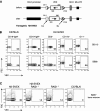

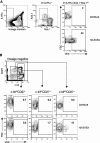
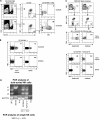
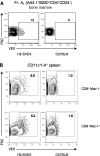
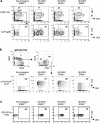
Similar articles
-
Developmental separation of V(D)J recombinase expression and initiation of IgH recombination in B lineage progenitors in vivo.J Exp Med. 2004 Feb 16;199(4):483-9. doi: 10.1084/jem.20031802. Epub 2004 Feb 9. J Exp Med. 2004. PMID: 14769853 Free PMC article.
-
E47 is required for V(D)J recombinase activity in common lymphoid progenitors.J Exp Med. 2005 Dec 19;202(12):1669-77. doi: 10.1084/jem.20051190. J Exp Med. 2005. PMID: 16365147 Free PMC article.
-
Bone marrow microenvironmental changes in aged mice compromise V(D)J recombinase activity and B cell generation.Semin Immunol. 2005 Oct;17(5):347-55. doi: 10.1016/j.smim.2005.05.012. Semin Immunol. 2005. PMID: 15963731 Review.
-
Induction of sterile transcription from the kappa L chain gene locus in V(D)J recombinase-deficient progenitor B cells.Int Immunol. 1995 Dec;7(12):1915-25. doi: 10.1093/intimm/7.12.1915. Int Immunol. 1995. PMID: 8746561
-
Accessibility and the developmental regulation of V(D)J recombination.Semin Immunol. 1997 Jun;9(3):161-70. doi: 10.1006/smim.1997.0066. Semin Immunol. 1997. PMID: 9200327 Review.
Cited by
-
Interferon-producing killer dendritic cells (IKDCs) arise via a unique differentiation pathway from primitive c-kitHiCD62L+ lymphoid progenitors.Blood. 2007 Jun 1;109(11):4825-931. doi: 10.1182/blood-2006-08-043810. Epub 2007 Feb 22. Blood. 2007. PMID: 17317852 Free PMC article.
-
Cbfbeta-SMMHC impairs differentiation of common lymphoid progenitors and reveals an essential role for RUNX in early B-cell development.Blood. 2008 Feb 1;111(3):1543-51. doi: 10.1182/blood-2007-07-104422. Epub 2007 Oct 16. Blood. 2008. PMID: 17940206 Free PMC article.
-
Detecting variable (V), diversity (D) and joining (J) gene segment recombination using a two-colour fluorescence system.Mob DNA. 2010 Mar 1;1(1):9. doi: 10.1186/1759-8753-1-9. Mob DNA. 2010. PMID: 20226006 Free PMC article.
-
NK cell development, homeostasis and function: parallels with CD8⁺ T cells.Nat Rev Immunol. 2011 Aug 26;11(10):645-57. doi: 10.1038/nri3044. Nat Rev Immunol. 2011. PMID: 21869816 Free PMC article. Review.
-
Flk2+ common lymphoid progenitors possess equivalent differentiation potential for the B and T lineages.Blood. 2008 Jun 15;111(12):5562-70. doi: 10.1182/blood-2007-11-126219. Epub 2008 Apr 18. Blood. 2008. PMID: 18424665 Free PMC article.
References
-
- Nutt, S.L., D. Eberhard, M. Horcher, A.G. Rolink, and M. Busslinger. 2001. Pax5 determines the identity of B cells from the beginning to the end of B-lymphopoiesis. Int. Rev. Immunol. 20:65–82. - PubMed
-
- Rothenberg, E.V., and C.J. Dionne. 2002. Lineage plasticity and commitment in T-cell development. Immunol. Rev. 187:96–115. - PubMed
-
- Mombaerts, P., J. Iacomini, R.S. Johnson, K. Herrup, S. Tonegawa, and V.E. Papaioannou. 1992. RAG-1-deficient mice have no mature B and T lymphocytes. Cell. 68:869–877. - PubMed
-
- Shinkai, Y., G. Rathbun, K.P. Lam, E.M. Oltz, V. Stewart, M. Mendelsohn, J. Charron, M. Datta, F. Young, A.M. Stall, et al. 1992. RAG-2-deficient mice lack mature lymphocytes owing to inability to initiate V(D)J rearrangement. Cell. 68:855–867. - PubMed
-
- Gao, Y., J. Chaudhuri, C. Zhu, L. Davidson, D.T. Weaver, and F.W. Alt. 1998. A targeted DNA-PKcs-null mutation reveals DNA-PK-independent functions for KU in V(D)J recombination. Immunity. 9:367–376. - PubMed
Publication types
MeSH terms
Substances
Grants and funding
LinkOut - more resources
Full Text Sources
Medical
Molecular Biology Databases
Research Materials
Miscellaneous

